Other World Computing has announced that it has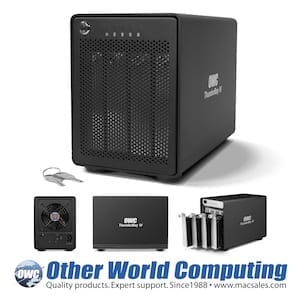 expanded its line of Thunderbolt interface storage products with the addition of the OWC ThunderBay IV four-bay external high-performance drive.
expanded its line of Thunderbolt interface storage products with the addition of the OWC ThunderBay IV four-bay external high-performance drive.
High-Performance Four-Bay Design
The ThunderBay IV, available in capacities up to 16TB of total storage, adds tremendous storage capacity and throughput to any Mac or PC with a Thunderbolt port. Applications such as A/V post-production, photography, music, graphics, data management, and even Time Machine backups are enhanced with access to data at sustained data rates of up to 887MB/s read, 884MB/s write.
Flexible for Individual Storage Needs
The ThunderBay IV supports independent drive access of up to four installed drives, is fully RAID ready, and is ideal for RAID 0, 1, and 5 configurations. Even combinations of RAID, individual drive(s) or multiple RAID sets are possible with OWC ThunderBay IV.
“We’re excited about the speed, capacity and flexibility that the ThunderBay IV can offer,” said Larry O’Connor, Founder and CEO, Other World Computing. “It’s the perfect mix of high-capacity storage with blazing fast Thunderbolt technology performance.”
Daisy Chain Capable
ThunderBay’s dual Thunderbolt ports allow daisy chaining of up to five additional devices plus one high-resolution display. Currently, up to 96TB of storage plus a display can be added using the ThunderBay IV solution with any Mac (or PC) via a single available Thunderbolt port.
Solid, Reliable and Cool
A durable aluminum enclosure protects the four internal drives and keeps them cool thanks to its superior heat dissipation. In addition, the locking faceplate keeps the installed drives secure at all times.
The Perfect Drive for Mac Pro Data Migration
No need to give up the versatility of drive bays when migrating from a Mac Pro tower to the Mac Pro 2013. Simply plug in the ThunderBay IV to a Mac Pro and see four drives with a Thunderbolt interface capable of running all drives at full speed — just as if installed internally. Users will have the speed and power of the Mac Pro, with the drive capacity and flexibility of previous generations, all with the extreme speed of Thunderbolt technology.
Key Features Include:
- RAID-ready for performance of up to 887MB/s read, 884MB/s write
- Plug & Play ready on any Mac or PC with Thunderbolt interface
- OWC Heavy Duty Power Supply for exceptional performance and reliability
- Front panel security lock with two keys
- Independent Drive support to allow use of any mix of one to four drives for RAID or JBOD
- Two Thunderbolt ports for daisy-chaining
- Support for High-Capacity Hard Drives for maximum storage needs
- 1.0 meter certified Thunderbolt cable included
- User Guide
- Utility software bundle for Mac and PC
- OWC Limited Warranty: up to 3 Years
Availability:
The OWC ThunderBay IV is available for immediate ordering from OWC and select retailers in the following configurations:
- Add-Your-Own Drive Enclosure Kit
- 4.0TB (1TB x four (4) 7200RPM)
- 8.0TB (2TB x four (4) 7200RPM)
- 12.0TB (3TB x four (4) 7200RPM)
- 16.0TB (4TB x four (4) 7200RPM)
- 480GB (120GB x four (4) OWC Mercury EXTREME Pro SSD)
- 1.0TB (240GB x four (4) OWC Mercury EXTREME Pro SSD)
- 2.0TB (480GB x four (4) OWC Mercury EXTREME Pro SSD)
- 4.0TB (960GB x four (4) OWC Mercury EXTREME Pro SSD)
For more information on the OWC ThunderBay IV, visit: eshop.macsales.com/shop/Thunderbolt/External-Drive/OWC/ThunderBay-IV
Your Stop for Thunderbolt Interface Upgrades
OWC also has available a full line of leading Thunderbolt interface solutions from external drives to drive enclosures, docks, adapters, cables, and more supporting the transition to this great new system: eshop.macsales.com/shop/Thunderbolt/
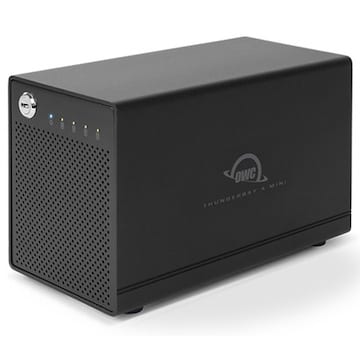


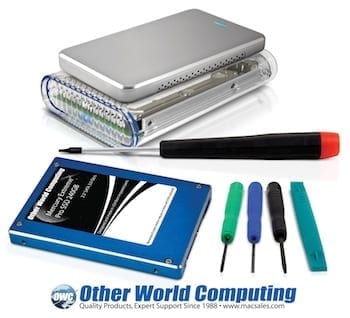

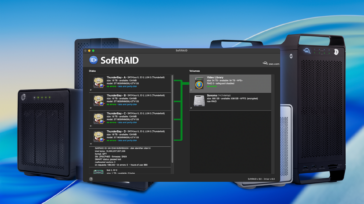
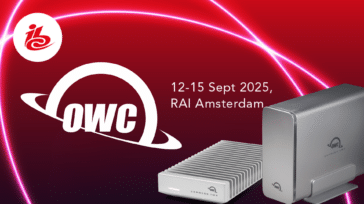



I think those complaining about the RAID capabilities of this enclosure are missing the point. If you need high speed RAID over Thunderbolt, go for the Pegasus or the 5BIG or another one of those crazy expensive RAID enclosures. Personally, I think this enclosure perfectly fills a gap for those transitioning to a 2013 Mac Pro from one of the older ones: a relatively cheap solution to use all four drives from a maxed-out MP JBOD setup in one enclosure.
I don’t use RAID. I don’t care about RAID. But I have an older Mac Pro with all four drive bays occupied with a wide range of drives (one 240 GB SSD, a 2 TB drive,and two 3TB drives). I can’t afford a new Mac Pro right now, but I’ve researched what it would take to migrate. And the ability to use my old drives with the new machine is one of the most significant barriers. In fact, this is the ONLY device I’ve found that can be ordered as a bare four-bay enclosure, capable of connecting natively with the nMP (I’m counting both Thunderbolt and USB3 devices here) and operating as JBOD. (I found one other four-drive JBOD enclosure with USB3, but it had the strange restriction that JBOD only functioned over its eSATA interface.)
I think $500 is still steep for a plain drive enclosure, but “steep” seems to be the norm for Thunderbolt devices, unfortunately. If I did the calculation correctly, a set of bare ministack enclosures can be configured for a bit less, but then you have at least two cables for each enclosure, plus you can’t daisy-chain them. So I think enclosure is a good solution for people who don’t have extreme needs and don’t have money to burn, but still want their desks somewhat neat.
I would have bought this if it had been thunderbolt 2. It would have saved me a lot of headaches at migration time. I will still probably buy the TB2 model of this when it finally comes out, unless something else comes along first.
Anyone wondering where the Thunderbolt 2 drives from OWC are, probably have a long wait.
The way I figure it:
Macs with Thunderbolt 1 came out in early 2011.
The first Thunderbolt 1 storage drives from OWC came out in early 2014.
Macs with Thunderbolt 2 came out in late 2013.
Bearing that in mind, we shouldn’t realistically expect Thunderbolt 2 storage drives from OWC until late 2016.
Oh, and SoftRAID doesn’t support RAID 5 and I don’t expect it ever will. I specifically asked about RAID 5 and the developer said it would be added by Macworld Expo….. IN 2007!! He stopped answering my requests in 2009.
I think OWC Jarrod may have jumped the gun a little when mentioning SoftRAID.
Yes, you are correct – SoftRAID 4.5 does not have RAID 5 capability. However, SoftRAID 5 is currently in beta testing and we’ve been getting some very positive reports from sites such as Mac Performance Guide on its performance.
Can you at least correct the blog entry and admit that the enclosure only does JBOD, RAID 1 and RAID 0?
No RAID 5 anywhere to be found on this box.
RAID 0 and RAID 1 can be accomplished using Disk Utility, and RAID 5 can be done using software such as SoftRAID.
Hello,
I have a question about Thunderbolt storage devices and have never found an answer in any of the reviews.
Is it possible to create a boot camp partition on the drive?
This is possible for internal drives but not for USB drives.
Hence internal drives are attached via PCIe-Sata controlers or for some latest models direct to PCIe it may be possible that Thunderbolt drives are treated the same way. But it may also depend on the firmware of the thunderbolt device. Does anyone know more?
There’s two kinds of PCIe SSDs. Those like the Accelsior that use a SATA controller on the PCIe bus aren’t really PCIe SSD. Real PCIe SSDs don’t use a SATA controller (which bypasses the 6Gb/s limitation). I don’t know how the latter works or how it appears to the firmware or OS. I would use an ioreg command and a dump from Apple System Profiler to figure that out. The ThunderBay IV probably uses a SATA controller because it uses SATA drives. The drives should appear as SATA drives on the PCIe bus.
BIOS booting might or might not work. I don’t know how the Accelsior supports that (does it have special firmware or does the Mac Pro’s BIOS firmware know how to boot from any SATA device?). Anyway, it doesn’t work 100% on all Mac Pros. In those cases, one of the internal drive bays has to be used. A similar situation might occur with the ThunderBay IV.
Alternatively, some Macs may be able to boot Windows 8 using EFI. This depends on the version of EFI on the Mac. I think the Mac needs EFI 2 (UEFI 2). In that case, it should be able to boot from any device that Mac OS X can boot from depending on the Windows EFI booting ability. It may be possible to convert a BIOS bootable partition into a EFI bootable partition by copying and editing the necessary EFI boot files to the proper locations. This would require some experimentation.
Dear Joe,
Thanks you for the replay. It may depend on the firmware of the used mac. For the mini the best way to get a multi boot solution ((Mac, win, linux…) is using virtualization if possible or moving out the internal sata port.
Gunter
The case and design is identical to the Mercury Elite Pro Qx2 but with different electronics inside, so what is the reason for a $200+ price difference on the bare-bones version? In fact if the electronics of the Qx2 are removed that makes the price difference even greater. Do the TB electronics have to cost way over $200? I think it’s a reasonable question that many people ask when they look at TB devices and compare to similar non-TB devices. Is it just the fact that demand is so low that prices must be high?
I agree. JBOD and TB 1 = yawn. I would hate to pay for this unit only to find out in a year OWC came out with the real box they meant to come out with.
I think the price is typical of Thunderbolt solutions.
$495: OWC ThunderBay IV: has 4 x SATA 6G.
$496: LaCie Thunderbolt to eSATA Hub + OWC Mercury Elite Pro Qx2 + Kanex 0.5M Thunderbolt Cable: only supports 1 x SATA 3G (the 4 internal SATA connectors have to go through a single external SATA 3G).
$300: OWC Mercury Elite Pro Dual: only has 2 x SATA 6G. I guess the $195 difference could equal the price of a SATA controller and drive enclosure. Two of these would cost $600 but might perform faster than a ThunderBay IV.
$448: OWC Mercury Helios + NewerTech MAXPower PCIe 4-Port eSATA 6G RAID 0/1/5/10/JBOD Controller Card ($98): but you need to add 4 external drive enclosures. The Sonnet Technologies Tempo SATA Pro 4 Port 6Gb/s eSATA PCIe Host Adapter at $278 may be a better match depending on the chipset used in the ThunderBay IV.
I would say that’s differently fair.
An Accelsior has access to 10 Gb/s like the ThunderBay IV but the Accelsior can only raid 2 6G SSDs. If you use two Accelsiors then they’ll have access to 4 6G SSDs like the ThunderBay IV but would have access to 20 Gb/s. I suppose you could RAID 4 6G SSDs on one Accelsior (2 internal and 2 external) by un-configuring the Acellsior’s RAID and using Software RAID. That would be the most equal comparison with any difference being caused only by the chipsets involved.
I only brought up the Accelsior to illustrate how a 10 Gb/s connection limits throughput. If you can raid two Accelsiors together, then you can just as easily get the same effect by raiding two ThunderBay IVs if they can utilize two Thunderbolt channels fully. I’m not sure how that all works though. Does a Thunderbolt device always use the same channel, or do they use whatever channel is free given that a thunderbolt cable always carries two channels (except in the case where the chipset only provides one channel)?
Bring Thunderbolt 2.
Is the connection Thunderbolt 1 or Thunderbolt 2 like the new Mac Pro? Also, how are 4 performance rated SSDs only hitting speeds of 880 MB/s? One drive is capable of over 500 MB/s, right?
Spec says Thunderbolt – 10 Gb/sec. So it must be Thunderbolt 1.
Thunderbolt uses PCIe 2.0 x4. Thunderbolt 1 splits that into two channels. Thunderbolt 2 can use both channels for 20 Gb/s.
10 Gb/sec means 1000 MB/s theoretical max. So 880 MB/s is not unexpected when you consider overhead. That’s like a Mercury Accelsior which RAIDs 2 6G SSDs together in a PCIe 2.0 x2 slot. A raid of 4 6G SSDs which gives 880 MB/s in the ThunderBay IV is only slightly better than the Mercury Accelsior.
Given the limits of TB 1, the throughput sounds like it is in the ballpark much like Joe explains.
However, to be clearer, the comparison to an Accelsior is just that: a single Accelsior card (albeit it raids to sticks residing on the one card).
A more fair comparison would be to at least 2 Accelsior cards raided together. That will get you speeds in the 1.2-1.3GB/s far outperforming this configuration. 3 Accelsior raided together puts you into the 1.7-1.8GB/s range which is twice the throughput TB 1 can provide.